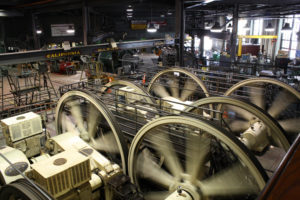San Francisco Cable Cars
By Wendy VanHatten

“If it pleases Providence to make a car run up and own a slit in the ground for many miles, and if for twopence-half penny I can ride in that car, why should I seek the reasons of the miracle?” Malcom E. Barker
Mention San Francisco to people and images come to mind of the Golden Gate Bridge, the Painted Ladies Victorian homes, Alcatraz…and the clanging of the cable cars. This tourist attraction and yet viable means of transportation came about due to a man witnessing a horrible accident on a typically damp summer day in 1869.

Andrew Smith Hallidie saw a horse drawn streetcar slide backwards on a damp cobblestone street, causing five horses to lose their lives. He knew he needed to do something about it. His father held the first patent in Great Britain for wire rope, and he used this technology in California’s gold country, in building a bridge in Sacramento, and in pulling heavy ore cars out of underground mines.
Using this technology, he devised a cable car system where giant wheels pull a wire cable through a trench embedded in a roadway. The cars attach to the cable and are pulled along. His first ride downhill, August 2, 1873, was alone as no one wanted to ride with him. Once he demonstrated their safety, cable cars dominated the city’s transit scene for more than 30 years.
Then came the 1906 Earthquake and Fire and they were almost extinguished.

In the 1890s there were eight active cable car companies, covering the city with 127 miles of track. Today, there is one combined line with 10.5 miles of track in three branches. Thirty-one cars, weighing six tons each, travel at a speed of 9.5 miles per hour up a 21 percent grade.
Whether this is your first time visiting San Francisco or if you want to enjoy the City by the Bay from an iconic landmark, hop aboard a cable car. Want some insider tips on best to enjoy your ride?
For the best views, you want to be on the side that faces the bay. For the Powell cars, that’s the east side. If the car is leaving downtown, you would want to be on the right side. If you’re at Fisherman’s Wharf, the left side. If you don’t know, ask the driver.
Exit off the car and wait for it to pass. Drivers always pay attention, but if something should happen, they can’t swerve to avoid you.
Cable cars are pretty good about staying on schedule. Unless, it’s raining. You might have a short wait in this case.
Wear a sweater. Even on a warm day, it can get cold on the cars. The warmest spots are on the inside. You won’t get the best views there, however.
Don’t let anything…purses, backpacks, kids…hang off the edge.
Hold on and watch your kids.
There are three different cable cars routes. The Powell/Hyde and Powell/Mason lines start at the busy intersection of Powel and Market. They head toward Fisherman’s Wharf. These are the most popular as they climb some great hills, giving riders fantastic views. The California/Van Ness line starts at California and Market and goes to Van Ness. You get different views from each line, so if you have time…ride more than one.
Cable cars stop almost every block on California and Powell/Mason lines.
Cable cars are not handicap accessible.
If there are long lines, walk a few blocks to the next stop. The car will probably be full and you’ll have to stand, but the wait is shorter. Your call.
You are allowed, with a ticket, to get on a cable car at any stop along the route. It will stop for you.
Cable cars start operations about 6 am and run until about 12:30 at night. They usually run every 10 minutes and run all year.
Fun Facts: Cable cars are the only moving National Monument in the world. There have been two women in history who have served as a gripman.
IF YOU GO: Visit the Cable Car Museum at 1201 Mason Street. This free museum offers you a chance to see the inner workings below the street, to watch the gigantic wheels that pull the cable cars, watch the sheaves, which are the pulleys, and view an original car from Andrew Hallidie’s Clay Street Hill Railroad.